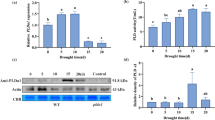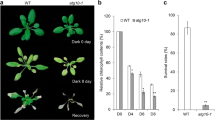Abstract
Cytosolic acyl-CoA binding proteins bind long-chain acyl-CoAs and act as intracellular acyl-CoA transporters and pool formers. Recently, we have characterized Arabidopsis thaliana cDNAs encoding novel forms of ACBP, designated ACBP1 and ACBP2, that contain a hydrophobic domain at the N-terminus and show conservation at the acyl-CoA binding domain to cytosolic ACBPs. We have previously demonstrated that ACBP1 is membrane-associated in Arabidopsis. Here, western blot analysis of anti-ACBP2 antibodies on A. thaliana protein showed that ACBP2 is located in the microsome-containing membrane fraction and in the subcellular fraction containing large particles (mitochondria, chloroplasts and peroxisomes), resembling the subcellular localization of ACBP1. To further investigate the subcellular localization of ACBP2, we fused ACBP2 translationally in-frame to GFP. By means of particle gene bombardment, ACBP2-GFP and ACBP1-GFP fusion proteins were observed transiently expressed at the plasma membrane and at the endoplasmic reticulum in onion epidermal cells. GFP fusions with deletion derivatives of ACBP1 or ACBP2 lacking the transmembrane domain were impaired in membrane targeting. Our investigations also showed that when the transmembrane domain of ACBP1 or that of ACBP2 was fused with GFP, the fusion protein was targeted to the plasma membrane, thereby establishing their role in membrane targeting. The localization of ACBP1-GFP is consistent with our previous observations using immunoelectron microscopy whereby ACBP1 was localized to the plasma membrane and vesicles. We conclude that ACBP2, like ACBP1, is a membrane protein that likely functions in membrane-associated acyl-CoA transfer/metabolism.
Similar content being viewed by others
References
Alho, H., Costa, E., Ferrero, P., Fujimoto, M., Cosenza-Murphy, D. and Guidotti, A. 1985. Diazepam-binding inhibitor: a neuropeptide located in selected neuronal populations of rat brain. Science 229: 179–182.
Bork, P. 1993. Hundreds of ankyrin-like repeats in functionally diverse proteins: mobile modules that cross phyla horizontally? Proteins: Struct. Funct. Genet. 17: 363–374.
Bradford, M.M. 1976. A rapid and sensitive method for the quantifi-cation of microgram quantities of protein utilizing the principle of protein-dye binding. Anal. Biochem. 72: 248–254.
Chye, M.-L. 1998. Arabidopsis cDNA encoding a membraneassociated protein with an acyl-CoA binding domain. Plant Mol. Biol. 38: 827–838.
Chye, M.-L., Huang, B.-Q. and Zee, S.-Y. 1999. Isolation of a gene encoding Arabidopsis membrane-associated acyl-CoA binding protein and immunolocalization of its gene product. Plant J. 18: 205–214
Chye, M.-L., Li, H.-Y. and Yung, M.-H. 2000. Single amino acid substitutions at the acyl-CoA-binding domain interrupt 14[C]palmitoyl-CoA binding of ACBP2, an Arabidopsis acyl-CoA-binding protein with ankyrin repeats. Plant Mol. Biol. 44: 711–721.
Færgeman, N.J. and Knudsen, J. 1997. Role of long-chain fatty acyl-CoAs esters in the regulation of metabolism and cell signaling. Biochem. J. 323: 1–12.
Fyrst, H., Knudsen, J., Schott, M.A., Lubin, B.H. and Kuypers, F.A. 1995. Detection of acyl-CoA-binding protein in human red blood cells and investigation of its role in membrane phospholipid renewal. Biochem. J. 306: 793–799.
Gaigg, B., Neergaard, T.B.F., Schneiter, R., Hansen, J.K., Færgeman, N.J., Jensen, N.A., Andersen, J.R., Friis, J., Sandhoff, R., Schroder, H.D. and Knudsen, J. 2001. Depletion of acylcoenzyme A-binding protein affects sphingolipid synthesis and causes vesicle accumulation and membrane defects in Saccharomyces cerevisiae. Mol. Biol. Cell. 12: 1147–1160.
Görlich, D. and Mattaj, I.W. 1996. Nucleocytoplasmic transport. Science 271: 1513–1518.
Gray, P.W., Glaister, D., Seeburg, P.H., Guidotti, A. and Costa, E. 1986. Cloning and expression of cDNA for human diazepam binding inhibitor, a natural ligand of an allosteric regulatory site of the ?-aminobutyric acid type A receptor. Proc. Natl. Acad. Sci. USA 83: 7547–7551.
Grebenok, R.J., Pierson, E., Lambert, G.M., Gong, F.-H., Afonso, C.L., Haldeman-Cahill, R., Carrington, J.C. and Galbraith, D.W. 1997. Green-fluorescent protein fusions for efficient characterization of nuclear targeting. Plant J. 11: 573–586.
Heinlein, M., Epel, B., Padgett, H.S. and Beachy, R.N. 1995. Interaction of tobamovirus movement proteins with the plant cytoskeleton. Science 270: 1983–1985.
Heinlein, M., Padgett, H.S., Gens, J.S., Pickard, B.G., Casper, S.J., Epel, B.L. and Beachy, R.N. 1998. Changing patterns of localization of the tobacco mosaic virus movement protein and replicase to the endoplasmic reticulum and microtubules during infection. Plant Cell 10: 1107–1120.
Hills, M.J., Dann, R., Lydiate, D. and Sharpe, A. 1994. Molecular cloning of a cDNA from Brassica napus L. for a homologue of acyl-CoA binding protein. Plant Mol. Biol. 25: 917–920.
Ivanchenko, M., Vejlupkova, Z., Quatrano, R.S. and Fowler, J.E. 2000. Maize ROP7 GTPase contains a unique, CaaX boxindependent plasma membrane targeting signal. Plant J. 24: 79–90.
Knudsen, J. 1991. Acyl-CoA binding and transport, an alternative function for diazepam binding inhibitor, which is identical with acyl-CoA binding protein. Neuropharmacology 30: 1405–1410.
Köhler, R.H., Cao, J., Zipfel, W.R., Webb, W.W. and Hanson, M.R. 1997a. Exchange of protein molecules through connections between higher plant plastids. Science 276: 2039–2042.
Köhler, R.H., Zipfel, W.R., Webb, W.W. and Hanson, M.R. 1997b. The green fluorescent protein as a marker to visualize plant mitochondria in vivo. Plant J. 11: 613–621.
Kolmer, M., Alho, H., Costa, E. and Pani, L. 1993. Cloning and tissue-specific functional characterization of the promoter of the rat diazepam binding protein inhibitor, a peptide with multiple biological actions. Proc. Natl. Acad. Sci. USA 90: 8439–8443.
Kolmer, M., Roos, C., Tirronen, M., Myohanen, S. and Alho, H. 1994. Tissue-specific expression of the diazepam-binding inhibitor in Drosophila melanogaster: cloning, structure and localization of the gene. Mol. Cell. Biol. 14: 6983–6995.
Kost, B., Spielhofer, P. and Chua, N.-H. 1998. A GFP-mouse talin fusion protein labels plant actin filaments in vivo and visualizes the actin cytoskeleton in growing pollen tubes. Plant J. 16: 393–401.
Kragelund, B.B., Knudsen, J. and Poulsen, F.M. 1999. Acylcoenzyme A binding protein (ACBP). Biochim. Biophys. Acta 1441: 150–161.
Laemmli, U.K. 1970. Cleavage of structural proteins during the assembly of the head of bacteriophage T4. Nature 227: 680–685.
Lihrmann, I., Plaquevent, J-C., Tostivint, H., Raijmakers, R., Tonon, M-C., Conlon, J-M. and Vaudry, H. 1994. Frog diazepambinding inhibitor: peptide sequence, cDNA cloning, and expression in the brain. Proc. Natl. Acad. Sci. USA 91: 6899–6903.
Mandrup, S., Hummel, R., Ravn, S., Jensen, G., Andreasen, P.H., Gregersen, N., Knudsen, J. and Kristiansen, K. 1992. Acyl-CoA binding protein/diazepam binding inhibitor gene and pseudogenes. A typical housekeeping gene family. J. Mol. Biol. 228: 1011–1022.
Kyte, J. and Doolittle, R.F. 1982. A simple method of displaying the hydropathic character of a protein. J. Mol. Biol. 157: 105–132.
Marquardt, H., Todaro, G.J. and Shoyab, M. 1986. Complete amino acid sequences of bovine and human endozepines. Homology with rat diazepam binding inhibitor. J. Biol. Chem. 261: 9727–9731.
Michaely, P. and Bennett, V. 1992. The ANK repeat: a ubiquitous motif involved in macromolecular recognition. Trends Cell Biol. 2: 127–129.
Mikkelsen, J. and Knudsen, J. 1987. Acyl-CoA binding protein from cow. Biochem. J. 248: 709–714.
Mikkelsen, J., Hojrup, P., Nielsen, P.F., Roepstorff, P. and Knudsen, J. 1987. Amino acid sequence of acyl-CoA-binding sequence from cow liver. Biochem. J. 245: 857–861.
Mocchetti, E., Einstein, R. and Brosius, J. 1986. Putative diazepam binding inhibitor peptide: cDNA clones from rat. Proc. Natl. Acad. Sci. USA 83: 7221–7225.
Pfanner, N., Orci, L., Glick, B.S., Amherdt, M., Arden, S.R., Maihotra, V. and Rothman, J.E. 1989. Fatty acyl-coenzyme A is required for budding of transport vesicles from Golgi cisternae. Cell 59: 95–102.
Rasmussen, J,T., Borchers, T. and Knudsen, J. 1990. Comparison of the binding affinities of acyl-CoA binding protein and fatty acid binding protein for long-chain acyl-CoA esters. Biochem. J. 265: 849–855.
Rasmussen, J.T., Færgeman, N.J., Kristiansen, K. and Knudsen, J. 1994. Acyl-CoA binding protein (ACBP) can mediate intermembrane acyl-CoA transport and donate acyl-CoA for ?-oxidation and glycerolipid synthesis. Biochem. J. 299: 165–170.
Rose, T.M., Schultz, E.R. and Todaro, G.J. 1992. Molecular cloning of the gene for the yeast homolog (ACB) of diazepam binding inhibitor/endozepine/acyl-CoA-binding protein. Proc. Natl. Acad. Sci. USA 89: 1287–1291.
Sambrook, J., Fritsch, E.F. and Maniatis, T. 1989. Molecular Cloning: A Laboratory Manual, 2nd ed. Cold Spring Harbor Laboratory Press, Plainview, NY.
Sentenac, H., Bonneaud,N., Minet, M., Lacroute, F., Salmon, J.-M., Gaymard, F. and Grignon C. 1992. Cloning and expression in yeast of a plant potassium ion transport system. Science 256: 663–665.
Smith, J.A., Krauss, M.R., Borkird, C. and Sung, Z.R. 1988. A nuclear protein associated with cell divisions in plants. Planta 174: 462–472.
Swinnen, J.V., Esquenet, M., Rossels, J., Claessens, F., Rombauts, W., Heyns, W. and Verhoeven, G. 1996. A human gene encoding diazepam-binding inhibitor/acyl-CoA-binding protein: transcription and hormonal regulation in the androgen-sensitive human prostatic adenocarcinoma cell line LNCaP. DNA Cell Biol. 15: 197–208.
Tusnády, G.E. and Simon, T. 1998. Principles governing amino acid composition of integral membrane proteins: applications to topology prediction. J. Mol. Biol. 283: 489–506.
von Arnim, A.G., Deng, X.W. and Stacey, M.G. 1998. Cloning vectors for the expression of green fluorescent proteins in transgenic plants. Gene 221: 35–43.
Webb, N.R., Rose, T.M., Malik, N., Marquardt, H., Shoyab, M., Todaro, G.J. and Lee, D.C. 1987. Bovine and human cDNA sequences encoding a putative benzodiazepine receptor ligand. DNA 6: 71–79.
Zimmermann, S., Talke, I., Ehrhardt, T., Nast, G. and Muller-Rober, B. 1998. Characterization of SKT1, an inwardly rectifying potassium channel from potato, by heterologous expression in insect cells. Plant Physiol. 116: 879–890.
Author information
Authors and Affiliations
Corresponding author
Rights and permissions
About this article
Cite this article
Li, HY., Chye, ML. Membrane localization of Arabidopsis acyl-CoA binding protein ACBP2. Plant Mol Biol 51, 483–492 (2003). https://doi.org/10.1023/A:1022330304402
Issue Date:
DOI: https://doi.org/10.1023/A:1022330304402




